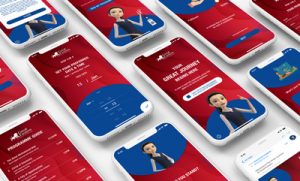According to the DMA, investing S$100 to market your products and services through email can equate to S$5,600 in profits.
Electronic Direct Mail, abbreviated as EDM, is considered a branch of email marketing known to be highly effective in the modern marketing landscape. A rise in delivery, open and click rates throughout the spectrum of email marketing has led to organisations heavily relying on it to advance business objectives. In the context of B2B companies, it is crowned as the most important channel that contributes to effective content marketing. Ever since its creation, marketers have repeatedly utilised EDMs to connect with the consumer through the ever-growing and ubiquitous platform, known as the internet.
A business would do well to take advantage of everything at their disposal to boost sales. In the past, this entailed handing out flyers to passers-by or creating tv and radio ads. Nowadays, online pay-per-click ads and social media posts dominate the advertising industry along with email marketing. The digital age we live in has brought with it many channels for organisations to introduce their offerings. New arrivals, timed sales, campaign details, newsletters and editorials can all be promoted through EDMs.
In the present age, many of us talk about sending EDMs more so as a buzzword rather than actually understanding what it means. To most of us, it is simply an email sent to prospective clients. However, there are differences between EDMs and email marketing; they should not be thought of as interchangeable. Rather, we should recognize that EDMs are an evolution of email marketing and represents the next stage in modern marketing methods.
EDMs Vs. Email Marketing

When Hotmail released its web email client in 1996, corporations saw it as a platform to raise awareness for their products and services. Emails were rapidly sent to any recipient they could find and contained misleading copy and attention-seeking images with the intent of getting click-throughs onto their website, also known as false advertising. This surge in blasting emails to consumers for the sole purpose of promoting a product gave rise to the term: Email marketing.
In light of its shortcomings, a new standard of online marketing was pioneered, namely EDMs. In terms of overall design, EDMs tend to be more visually appealing. Images are carefully selected and precisely positioned with appropriate backgrounds to look distinct and tasteful. Copy is constructed to be honest but enticing at the same time.

Personalisation is also implemented into EDMs. Simple modifications like incorporating your recipients name into the title can add a significant amount of meaning and depth into the message. When users feel acknowledged by the email, their engagement will increase and are more likely to respond positively. This contrasts with emails from the early 2000s that disregard personalisation and prioritises sending out generic emails to as many people as possible.

The concept of market segmentation is applied to EDMs as well. When we categorise and separate our mailing list according to demographics, we gain the ability to send out tailor-made emails for a specific demographic. We enhance the personalisation aspect of the email and gain even more engagement from our audience.
Thus, these new EDM standards have dictated how email marketing operates in modern times. Organisations have taken notice of these trends and are rethinking how they approach their consumers online.
Benefits of EDMs

Adopting EDM and its attributes offers consumers a seamless look into the brand and its offerings. To emphasise this, let’s do a comparison between 2 common ways a customer explores their options: Web browsing and EDM.
With Christmas around the corner, everyone will be looking for potential gifts for their loved ones. In this internet age, it is a recurring theme that shoppers will source for gift ideas and products online. They will be met with countless ads from a myriad of brands trying to grab their attention. In this case, businesses that invest money into being the top result on Google will fare better in product awareness – but it comes at a high cost.
Shifting perspective to EDMs, it offers a cost-effective business model and an absence of unending bid wars for the customer’s attention. Instead of constantly supplying more funds to appear on search results, EDMs use impactful designs and tactful copy to get noticed. The use of different text sizes, fonts, colours and images with a gripping title will allow us to direct the user’s attention to where we want it to be.

Convenience plays a crucial role in consumer behaviour. Although minor, the difference between typing out a search enquiry as compared to a single click of an email can determine what a customer looks at. EDMs, essentially, are delivered right to your email doorstep. Most working adults are occupied by work and other responsibilities that they overlook certain needs and wants; that is until stumbling upon an email tailored to their interests.

Making a customer feel exclusive is a concept that defines good marketing. Rather than sending out emails to your entire mailing list, we can target a segment of consumers by offering exclusive promotions that only they have access to. This builds a mutually beneficially relationship between businesses and customers that comprise of loyalty and trust.
Tips on creating your next EDM:

The first step to transform an ordinary email to an EDM is to craft a title that is unique and appealing. As our average attention spans decrease, so must our titles. Exceptionally short titles generally fail to convey enough detail on why someone should read it, while long titles struggle to retain attention and end up being half-read. Numerous analyses have been conducted on this topic, with 6 to 10 words being the most successful in getting people to click. Cramming in as much information as possible into an average of 8 words is a challenge, but those that manage to get their message across and stay within the limit will enjoy better click-to-open rates.

On the topic of open rates, the past decade has seen a major shift in email platforms. Comparing desktop and mobile open rates, 73% of emails were opened on a desktop in the year 2011. 7 years later, that number has dwindled to 39%. With mobile opens dominating the email environment, ensuring that an EDM displays well on all platforms becomes a critical factor. Emails that look distorted on mobile are red flags to a consumer and shows that the company is lacking in quality assurance. From email platforms to specific mail applications, it is paramount that emails look good on every application in every device.

To make the reader feel special, an email should be personalised. As previously said, simply adding your recipient’s name is personalisation – but much more can be done. When we segment our emails according to age groups, job history, marital status, etc., we give ourselves the opportunity to showcase products and mention topics that are relevant to their needs. By repeatedly disseminating emails that pique their interest, a sense of desirability and expectation will manifest. Consumers will look forward to emails, instead of treating it as spam. It elevates the brand above its competition and is also a great opportunity to advertise new iterations of an outdated product that people might not be aware of.
Depending on a company’s objectives, emails should aim to create a specific image for themselves. This is purported by the content in their EDMs. For brands that are constantly innovating and producing new products, their EDMs should promote them as well. The consistent marketing of the latest merchandise allows readers to think of the brand as a leading pioneer in the industry. In contrast, brands that are focused on delivering the best deals on goods – including outdated items – have the flexibility of curating EDMs to market products according to value. Both types of brands give out different impressions to customers, and it is important that internal staff understand their brand’s image before constructing one.
Effective, Engaging, EDM
An EDM should aim, first and foremost, to earnestly engage the user. Unlike emails of the past, EDMs encompass a set of unspoken rules that companies should comply with. As the industry becomes more competitive, these rules become standards.
The benefits of EDMs are apparent. Modern aesthetics combined with impactful copy injects vibrancy into what would otherwise be generic product advertising. When we decorate our offerings with engaging graphics and empowering descriptions, we elevate the consumer’s impressions of both the product and the brand. Through EDMs, we forge a relationship with our audience and encourage continued loyalty – presenting ourselves as a brand that is forward-thinking and assured of our goals.
As an interactive media agency, one of our goals is to constantly reinvent ourselves and never rest on our laurels. Subscribe to Trinax’s mailing list here and get up to date on the latest digital concepts and offerings to boost your brand’s image.






